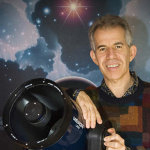Humberto Campins

Pegasus Professor
Department of Physics
PSB 459
407-823-0251
humberto.campins@ucf.edu
Research Groups
After receiving his Ph.D. Dr. Campins had a postdoctoral appointment at the University of Maryland and spent five years at the Planetary Science Institute in Tucson. In 1989, he accepted an assistant professorship at the University of Florida, where he attained the rank of Professor in 1997. While at the University of Florida, Dr. Campins was Director at the Florida Space Grant Consortium from 1994 to 1998. From 1998 to 2002, Dr. Campins worked as Program Officer at the Research Corporation and as research faculty at the Lunar and Planetary Laboratory of the University of Arizona in Tucson. In August 2002, Dr. Campins joined the UCF faculty as Provost Research Professor of Physics and Astronomy and head of the Planetary and Space Science Group. In 2013, Dr. Campins was named Pegasus Professor, the highest award attainable by a UCF faculty member; he has also received two teaching awards and a number of research awards.
Dr. Campins’ research area is astronomy. He studies asteroids, comets and other small bodies in the solar system using a variety of ground based, airborne and space based telescopes. This research is funded by NASA and by the National Science Foundation. One of his current interests is the role that asteroids and comets may have played in the origin of water and organic molecules on Earth and Mars. Dr. Campins is a co-investigator on NASA’s OSIRIS-REx sample return mission to a near-Earth Asteroid, scheduled for launch in September 2016. He is also a co-investigator in UCF’s new Center for Lunar and Asteroid Surface Science (CLASS) funded by NASA’s Solar System Exploration Research Virtual Institute (SSERVI). He was the leader of one of two teams to discover water ice and organics on the surface of an asteroid.
| Authors | Title | Published Date | Journal |
|---|---|---|---|
| Pinilla-Alonso, Noemi; De Pra, Mario Nascimento; de León, Julia; and 11 coauthors | PRIMASS-L Spectra Bundle V2.0 | Jan 2024 | NASA Planetary Data System , 114 |
| Pinilla-Alonso, Noemi; De Pra, Mario Nascimento; de León, Julia; and 10 coauthors | PRIMASS-L Spectra Bundle V1.0 | Jan 2021 | NASA Planetary Data System , 183 |
| DellaGiustina, D. N.; Kaplan, H. H.; Simon, A. A.; and 34 coauthors | Exogenic basalt on asteroid (101955) Bennu | Jan 2021 | Nature Astronomy 5, 31 |
| Lowry, Vanessa C.; Vokrouhlický, David; Nesvorný, David; and 1 coauthor | Clarissa Family Age from the Yarkovsky Effect Chronology | Sep 2020 | The Astronomical Journal 160, 127 |
| Molaro, J. L.; Walsh, K. J.; Jawin, E. R.; and 14 coauthors | In situ evidence of thermally induced rock breakdown widespread on Bennu’s surface | Jun 2020 | Nature Communications 11, 2913 |
